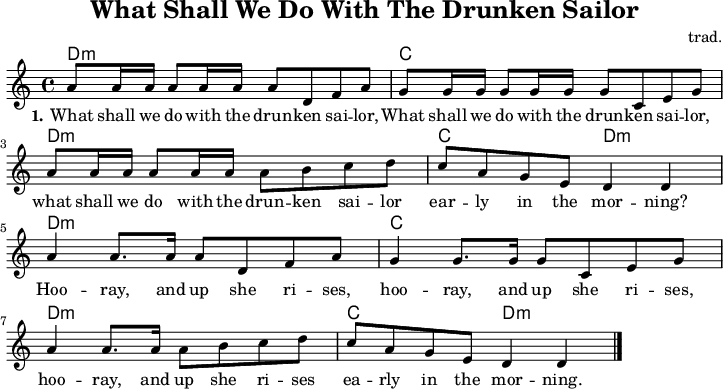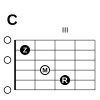Gitarre: Liedbeispiel 11a
What Shall We Do With The Drunken Sailor
[Bearbeiten]Shanty (Seemannslied) Alternativtitel: Drunken Sailor • Text: anonym (publ. 1891) Melodie: trad.(um 1745) Tonart: dorisch bearbeitet von Mjchael
| Gitarre | Ukulele (gcea) | |||||
|---|---|---|---|---|---|---|
|

- 1. Strophe
- [Dm] What shall we do with the drunken sailor [C] What shall we do with the drunken sailor
- [Dm] What shall we do with the drunken sailor [C] Early in the[Dm]morning?
- Refrain
- [Dm] Hoo-ray, and up she rises [C] Hoo-ray, and up she rises
- [Dm] Hoo-ray, and up she rises [C] Early in the[Dm]morning
- 2. Strophe
- [Dm] Put him in the long boat until he's sober[1] [C] Put him in the long boat until he's sober
- [Dm] Put him in the long boat until he's sober [C] Early in the[Dm] morning
- 3. Strophe
- [Dm] Pull out the plug[2] and wet[3] him all over [C] Pull out the plug and wet him all over
- [Dm] Pull out the plug and wet him all over [C] Early in the[Dm]morning
- 4. Strophe
- [Dm]Take him and shake him and try to awake him[C]Take him and shake him and try to awake him
- [Dm]Take him and shake him and try to awake him[C]Early in the[Dm]morning
- 5. Strophe
- [Dm] Give him a dose of salt and water [C]Give him a dose of salt and water
- [Dm]Give him a dose of salt and water [C] Early in the[Dm]morning
- 6. Strophe
- [Dm] Give him a dash with a bosun's[4] rope-end[5] [C]Give him a dash with a bosun's rope-end
- [Dm]Give him a dash with a bosun's rope-end [C] Early in the[Dm]morning
- 7. Strophe
- [Dm] Haeve him by the leg in a running bowline[6] [C]Haeve him by the leg in a running bowline
- [Dm]Haeve him by the leg in a running bowline [C] Early in the[Dm]morning
- 8. Strophe
- [Dm] Put him in the scuppers[7] with a hose pipe[8] on him [C]Put him in the scuppers with a hose pipe on him
- [Dm]Put him in the scuppers with a hose pipe on him [C] Early in the[Dm]morning
- 9. Strophe
- [Dm] Shave his belly with a rusty razor [C]Shave his belly with a rusty razor
- [Dm]Shave his belly with a rusty razor [C] Early in the[Dm]morning
- 10. Strophe
- [Dm] That´s what to do with a drunken sailor [C]That´s what to do with a drunken sailor
- [Dm]That´s what to do with a drunken sailor [C] Early in the[Dm]morning
- ↑ sober = nüchtern
- ↑ plug = Stöpsel(eines Kruges oder Fasses)
- ↑ wet = feucht, nass (machen)
- ↑ bosun: eigentlich "boatswain" = Bootsmann
- ↑ rope-end = Tau- bzw. Seilende
- ↑ running bowline = Palsteg (Seemanns-Knoten)
- ↑ scuppers = Speigatte (Seemansbegriff für ein Abflussloch von Seewasser)
- ↑ hose pipe = Schlauch
Der Autor ist vor über siebzig Jahren verstorben. Daher bestehen keine Urheberrechtsansprüche mehr an diesem Werk.
Etwas Harmonielehre
[Bearbeiten]Die Tonart des Liedes ist weder C-Dur noch D-Moll und auch nicht F-Dur, wie es in einigen Notenbüchern fälschlicherweise geschrieben wird.
Das Notenmaterial ist das gleiche wie C-Dur, daher werden die selben Vorzeichen wie bei der C-Dur-Tonleiter verwendet (nämlich keine).
Doch das harmonische Zentrum des Liedes ist der D-Moll-Akkord und nicht der C-Dur-Akkord. Wie du siehst und hörst, beginnt und endet jede Strophe nebst Refrain mit dem Dm.
Von C-Dur aus gesehen ist D-Moll die zweite Akkordstufe. Lieder, deren Zentrum der zweiten Stufe einer Durtonleiter entsprechen, nennt man "dorisch". Dieses ist eine Kirchentonart; so genannt, weil noch viele alte Kirchenlieder in solchen Tonarten stehen. Es gibt auch viele Volkslieder (besonders im Irish Folk) und auch moderne Pop-Songs (z.B. Mad World - gecovert von Michael Andrews) die ebenfalls diesen Modus (= anderes Wort für Kirchentonart) verwenden.
Weblinks
[Bearbeiten]Alternativer Text What shall we do with the drunken sailor



